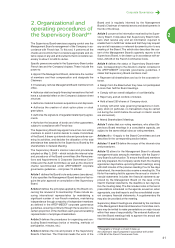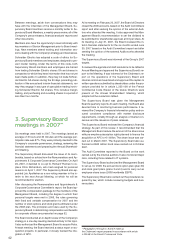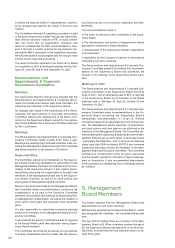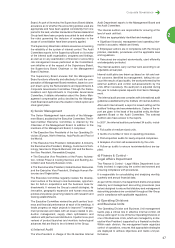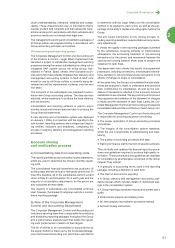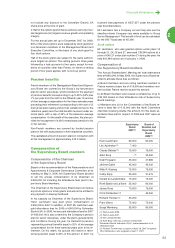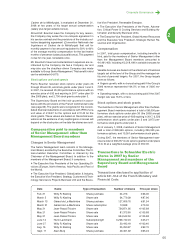APC 2007 Annual Report Download - page 51
Download and view the complete annual report
Please find page 51 of the 2007 APC annual report below. You can navigate through the pages in the report by either clicking on the pages listed below, or by using the keyword search tool below to find specific information within the annual report.
49
Corporate Governance
2
of management and performance for which the Group has
committed to a maximum level of efficiency and quality.
Senior Management tracks these indicators monthly. Ac-
tion plans are deployed immediately when areas of risk or
improvement are identified.
Financial review meetings
The financial position of all Group companies is reviewed
once a year by Group Finance & Control - Legal Affairs.
The process includes, for each unit:
An analytical review of the balance sheet and of capital
employed.
An analytical review of working capital and customer
credit.
An analysis of financial risks (liquidity, currency, coun-
terparty and credit risks).
A review of compliance with internal rules governing in-
tercompany payments and transfer pricing.
A review of the membership of the unit's Board of Di-
rectors or equivalent.
Monthly Treasury Committee meetings
This Committee, chaired by the Executive Vice President,
Finance & Control - Legal Affairs, reviews the Group's
monthly cash position, foreign currency position and fi-
nancing capacity.
Foreign currency transactions for all entities are managed
at Group level, except for those involving soft currencies.
Schneider Electric has established internal control rules
governing foreign exchange exposure – only the operating
receivables and payables of each entity and intercompany
financial receivables and payables (dividends, loans and
borrowings) are hedged – and the accounting treatment of
foreign currency transactions.
b) Specific procedures applicable to certain
types of risks or transactions
Integration of newly-acquired businesses
The integration of newly-acquired businesses is a process
that extends over a period of 6 to 24 months depending on
the type and size of the new entity.
The integration scenario for each acquisition varies de-
pending on whether the business was acquired to
strengthen the Group’s existing lineup, extend the lineup
or penetrate a new segment.
All told, there are five scenarios ranging from total integra-
tion to separate organization reporting to Senior Manage-
ment. Depending on the strategic objective, a matrix is
drawn up showing the required level of integration for each
of the newly-acquired business’s core functions, i.e. front
office (sales force and brand), back office, R&D, corporate
functions and management reporting.
An integration plan is drawn up for each acquisition and
submitted to the Acquisitions Committee for approval. The
plan is implemented by an integration manager who re-
ports to a Steering Committee that initially meets at
monthly intervals and then on a quarterly basis.
New product development
The New Products Committee allocates resources among
new product development, range management and tech-
nological research.
Management processes for technological projects have
been harmonized throughout the Group to allow more ef-
fective tracking of resource allocation and return on in-
vestment.
Industrial property
The patents developed or purchased by the Group are
tracked by the Industrial Property team within the Finance
& Control - Legal Affairs Department. All industrial prop-
erty information for the main Group subsidiaries is trans-
mitted to this team, which is responsible for managing and
protecting these intangible assets around the world. The
same procedure is followed for trademarks.
Purchases
A key process in Group operations, purchases represent
around half of consolidated revenue.
Rules governing purchases mainly concern purchasing de-
partment organization and procedures, relationships be-
tween buyers and vendors, levels of signature authority,
and compliance with environmental standards. Internal
audit plans for individual subsidiaries or units systemati-
cally cover the purchasing function and include productiv-
ity and cost of non-quality analyses, compliance reviews
and analyses of the vendor portfolio.
Internal control procedures
governing the production
and processing of accounting
and financial information
The consolidated financial statements for all fiscal years
commencing on and after January 1, 2005 have been pre-
pared in accordance with International Financial Report-
ing Standards (IFRS), to comply with European Union
regulation 1606/2002.
Internal control procedures
to confirm the existence and value
of assets and liabilities
Internal control procedures generally consist of defining
levels of responsibility for authorizing and checking trans-
actions, and segregating tasks to help ensure that all trans-
actions are justified. In addition, integrated statutory and
management reporting systems have been developed to
guarantee the completeness of transaction data recorded
in the accounts.
Each subsidiary is responsible for implementing proce-
dures providing an adequate level of internal control. Op-
erating Division management teams assist the units in this
process and represent a first level of control in the appli-
cation of procedures.
Intangible assets
The process for valuing software and product development
costs is designed to monitor and analyze expenses, iden-
tify the portion of those expenses that meet the definition
of an asset and may be capitalized, and track the asset’s
use over time.
IT systems have been deployed to track project develop-
ment costs and measure the profitability of new products
more accurately.




